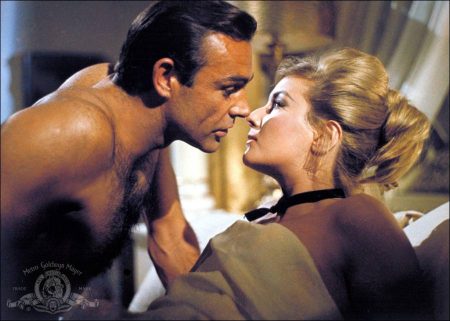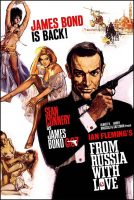From Russia with Love movie storyline. Seeking revenge against MI6 Agent 007 James Bond for the death of their agent Dr. No in Jamaica, international criminal organisation SPECTRE begins training agents to kill him. Irish assassin Donald “Red” Grant proves himself by quickly killing a fake Bond with a garrote concealed in his wristwatch during training.
SPECTRE’s chief planner, Czech chess grandmaster Kronsteen (Number 5), devises a plan to play British and Soviet intelligence against each other to procure a Lektor cryptography device from the Soviets and lure Bond to his assassination. SPECTRE’s chief executive (Number 1) puts Rosa Klebb (Number 3), a former SMERSH (Soviet counter-intelligence) colonel, in charge of the mission. Klebb chooses Grant to protect Bond until he acquires the Lektor, then eliminate 007 and steal the machine for SPECTRE (to be eventually sold back to its legitimate owner). Klebb also recruits Tatiana Romanova, a cipher clerk at the Soviet consulate in Istanbul, who believes Klebb is still working for SMERSH.
In London, M informs Bond that Romanova has contacted “Station T” in Turkey, offering to defect with a top-secret Lektor on the condition that Bond handle her case personally. M decides the chance of obtaining a Lektor is worth the risk, and Q gives Bond an attaché case with concealed throwing knife, gold sovereigns, a tear gas booby trap, and an ArmaLite AR-7 sniper rifle.
In Istanbul, Bond meets station head Ali Kerim Bey, tailed by Bulgarian agents working for Russia, who are, in turn, tailed by Grant; he kills one agent and dumps their car outside the Soviet Consulate. The Soviets bomb Kerim’s office with a limpet mine in retaliation, but he is away from his desk with his mistress. He and Bond spy on a Soviet consulate meeting through a periscope in the aqueducts beneath Istanbul, and learn that Soviet agent Krilencu is responsible for the bombing. Kerim and Bond lay low at a rural gypsy settlement, where Krilencu attacks them with a band of Bulgarians; Bond is saved by a sniper shot from Grant. Bond and Kerim track down Krilencu, and Kerim kills him with Bond’s rifle.
Bond finds Romanova in his hotel suite and they have sex, neither aware SPECTRE is filming them. Romanova brings the consulate floor plans to the Ayasofya Müzesi, formally the Hagia Sophia, and Grant kills the other Bulgarian to ensure Bond receives them. Using the plans, Bond and Kerim steal the Lektor and escape with Romanova aboard the Orient Express. Kerim and Bond subdue a Soviet security officer named Benz tailing them. Grant kills Kerim and Benz, preventing Bond from rendezvousing with one of Kerim’s men.
From Russia with Love is a 1963 spy film and the second in the James Bond series produced by Eon Productions, as well as Sean Connery’s second role as MI6 agent James Bond. It was directed by Terence Young, produced by Albert R. Broccoli and Harry Saltzman, and written by Richard Maibaum and Johanna Harwood, based on Ian Fleming’s similarly named 1957 novel. In the film, Bond is sent to assist in the defection of Soviet consulate clerk Tatiana Romanova in Turkey, where SPECTRE plans to avenge Bond’s killing of Dr. No.
Following the success of Dr. No, United Artists greenlit a sequel and doubled the budget available for the producers. In addition to filming on location in Turkey, the action scenes were shot at Pinewood Studios, Buckinghamshire, and in Scotland. Production ran over budget and schedule, and was rushed to finish by its scheduled October 1963 release date.
From Russia with Love was a critical and commercial success. It took in more than $78 million in worldwide box-office receipts, far more than its $2 million budget and more than its predecessor Dr. No, thereby becoming a blockbuster in 1960s cinema. This film also marked the debut of Desmond Llewelyn as Q, a role he would play for 36 years (and seventeen films) until The World Is Not Enough in 1999.
About the Production
Following the financial success of Dr. No, United Artists greenlit a second James Bond film. The studio doubled the budget offered to Eon Productions with $2 million, and also approved a bonus for Sean Connery, who would receive $100,000 along with his $54,000 salary. As President John F. Kennedy had named Fleming’s novel From Russia with Love among his ten favourite books of all time in Life magazine, producers Broccoli and Saltzman chose this as the follow-up to Bond’s cinematic debut in Dr. No. From Russia with Love was the last film President Kennedy saw at the White House on 20 November 1963 before going to Dallas.
Most of the crew from the first film returned, with major exceptions being production designer Ken Adam, who went to work on Dr. Strangelove and was replaced by Dr. No’s art director Syd Cain; title designer Maurice Binder was replaced by Robert Brownjohn, and stunt coordinator Bob Simmons was unavailable and was replaced by Peter Perkins though Simmons performed stunts in the film. John Barry replaced Monty Norman as composer of the soundtrack.
The film introduced several conventions which would become essential elements of the series: a pre-title sequence, the Blofeld character (referred to in the film only as “Number 1”) (though Blofeld is mentioned in the end credits, with the actor referred to only as “?”), a secret-weapon gadget for Bond, a helicopter sequence (repeated in every subsequent Bond film except The Man with the Golden Gun), a postscript action scene after the main climax, a theme song with lyrics, and the line “James Bond will return/be back” in the credits.
From Russia with Love (1964)
Directed by: Terence Young
Starring: Sean Connery, Robert Shaw, Lotte Lenya, Daniela Bianchi, Pedro Armendáriz, Eunice Gayson, George Pastell, Walter Gotell, Martine Beswick, Vladek Sheybal, Aliza Gur, Nadja Regin
Screenplay by: Richard Maibaum
Cinematography by: Ted Moore
Film Editing by: Peter R. Hunt
Costume Design by: Jocelyn Rickards
Art Direction by: Syd Cain
Music by: John Barry
MPAA Rating: None.
Distributed by: United Artists
Release Date: May 27, 1964
Visits: 292



